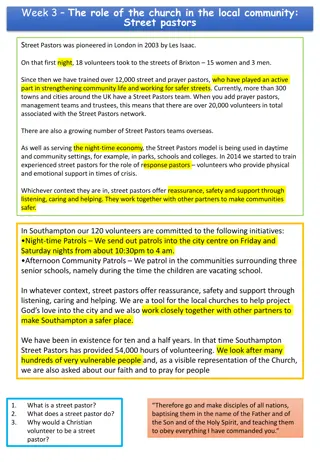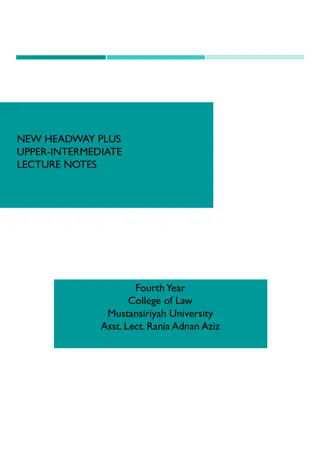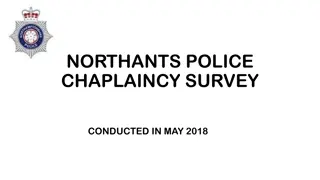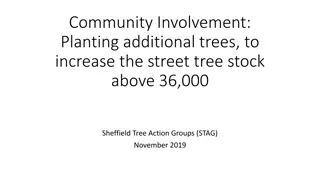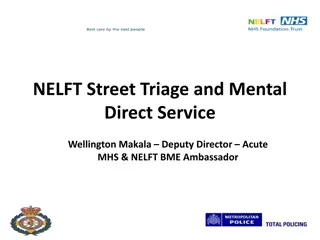Unfolding the Present of Presence in Street Chaplaincy: Analyzing Case Studies by Niels den Toom, Ph.D.
This analysis delves into the essence of presence in street chaplaincy through case studies. It explores the empirical study with street chaplains, emphasizing the relational focus and holistic approach. The Presence Theory developed by Andries Baart is discussed, highlighting the challenges and successes in being present in the fragile contexts these chaplains operate in. The findings reveal the importance of attuning to clients' needs, expressing genuine interest, and holding their dignity through reciprocity and shared tasks.
Download Presentation

Please find below an Image/Link to download the presentation.
The content on the website is provided AS IS for your information and personal use only. It may not be sold, licensed, or shared on other websites without obtaining consent from the author. Download presentation by click this link. If you encounter any issues during the download, it is possible that the publisher has removed the file from their server.
E N D
Presentation Transcript
Unfolding the present of presence in street chaplaincy. Analyzing case studies Niels den Toom, Ph.D, assistant professor in chaplaincy studies
Remaining present and engaged in a fragile world - Street chaplaincy as a fragile context par excellence. - Based on an empirical study with street chaplains as co- researchers Exploring the notion of presence Methodological remarks on the empirical study Presenting the main findings Reflections: what insights can we draw from this project?
Presence Theory of presence, as developed by Andries Baart (2001; 2002), based on chaplaincy in urban areas. Relational focus as opposed to an interventionist approach. Critique of culture: prioritizing the needs and life world of clients. Clients come to chaplains vs. chaplain comes to clients. Problem based vs. holistic
Presence It s success has paradoxically been it s problem. Other professions have adopted the model (Kluft et al., 2011). being present is not sufficient anymore to account for one s work. Value-orientation of the theory (strength) It focuses more on ideals and intentions than on actual behavior and knowledge (weakness). What do street chaplains do, when they want to be present?
Case studies into street chaplaincy Dutch Case Studies Project (Walton & K rver, 2017; Walton, K rver, & Den Toom (forthcoming)). Description and analysis of accompaniment process. Working with a set format of several questions. Focus on concrete behavior, more than intentions. Discussion and analysis in research communities with chaplains as co-researchers Present study with street chaplains: Part of a bigger research project on Chaplaincy in homebased care situations. Research community of 6 street chaplains, and three academic scholars. Every chaplain wrote one case study. Focus on: what do chaplains do, to what ends and with what results? Limitiations: no female clients, focus on individual contact, only Christian chaplains.
Findings: Two basic movements Attuning (in time, place and life world). Intentionally going to find your clients where they are , expressing genuine interest. Acknowledging and Holding Dignity (through reciprocity, sharing tasks, addressing strengths). When a street chaplain was allowed to one of their clients who was about to lose his house again, the chaplain negotiated to assemble new curtains. As no one else was permitted in the house by the client, the chaplain navigates carefully. In several phases of the process, she asks: is it okay, that we now enter your house? Please tell us, if you don t want it . Instead of just executing what they had agreed upon, the chaplain actively gives the client agency to decide himself. By doing so, the house remains the house of the client, and the chaplain emphasizes his dignity.
Findings: additional interventions Four additional steps Conversation Creating order and clarification Hermeneutical conversations Providing counsel Practical help Mediation Performing rituals
Findings: Conversations Conversation Creating order and clarification Hermeneutical conversations In a case study, the chaplain suggests that the military background of the client might hinder him in his communication with the housing corporation. Where he was used that his orders were followed, this does not work in his new life . By connecting his present experiences to his life story, the client gains insight into the often troubled connection with the housing corporation. Providing counsel Following an incident where a client robbed someone else in the shelter, the client went on a spontaneous pilgrimage. After some weeks, the client decides to call the chaplain. He tells about his pilgrimage and they reflect on whether the pilgrimage is a flight from somewhereor a journey towards somewhere. They discuss what a good life entails.
Findings Practical help Mediation Performing rituals
Reflections They do a lot more than being present. Meaningful presence as specification of chaplains presence. The importance of materiality is remarkable. It bears meaning. Are we too focused on conversations? Materiality also bears meaning. Mediation seems to be an important role, in which the conversation and material come together.
Questions - To what extent does the way street chaplains work, align with your work as a chaplain? In the study, conversations were only a small part of what chaplaincy is. How does the non-narrative or even non-verbal play a role in your work? What does this mean for the narrative focus of many chaplaincy theories? How can presence be practiced and legitimized in an increasingly evidence- based and instrumentalizing culture of care? - -








